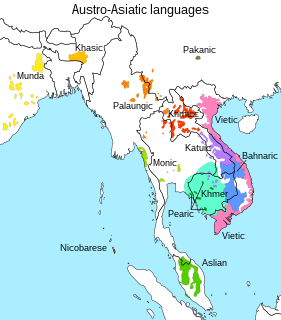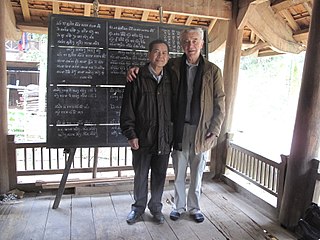Related Research Articles

The Austroasiatic languages, also known as Mon–Khmer, are a large language family in Mainland Southeast Asia. These languages are scattered throughout parts of Thailand, India, Bangladesh, Nepal, and southern China. There are around 117 million speakers of Austroasiatic languages. Of these languages, only Vietnamese, Khmer, and Mon have a long-established recorded history. Only two have official status as modern national languages: Vietnamese in Vietnam and Khmer in Cambodia. The Mon language is a recognized indigenous language in Myanmar and Thailand. In Myanmar, the Wa language is the de facto official language of Wa State. Santali is one of the 22 scheduled languages of India. The rest of the languages are spoken by minority groups and have no official status.

Khmer is an Austroasiatic language spoken by the Khmer people, and the official and national language of Cambodia. With approximately 16 million speakers, it is the second most widely spoken Austroasiatic language. Khmer has been influenced considerably by Sanskrit and Pali, especially in the royal and religious registers, through Hinduism and Buddhism. It is also the earliest recorded and earliest written language of the Mon–Khmer family, predating Mon and Vietnamese, due to Old Khmer being the language of the historical empires of Chenla, Angkor and, presumably, their earlier predecessor state, Funan.

Vietnamese is an Austroasiatic language that originated in Vietnam, where it is the national and official language. It is by far the most spoken Austroasiatic language with over 90 million native speakers, at least seven times more than Khmer, the next most spoken Austroasiatic language. Its vocabulary has had significant influence from Chinese and French. It is the native language of the Vietnamese (Kinh) people, as well as a second language or first language for other ethnic groups in Vietnam. As a result of emigration, Vietnamese speakers are also found in other parts of Southeast Asia, East Asia, North America, Europe, and Australia. Vietnamese has also been officially recognized as a minority language in the Czech Republic.
A vowel is a syllabic speech sound pronounced without any stricture in the vocal tract. Vowels are one of the two principal classes of speech sounds, the other being the consonant. Vowels vary in quality, in loudness and also in quantity (length). They are usually voiced and are closely involved in prosodic variation such as tone, intonation and stress.
In linguistics, vowel length is the perceived length of a vowel sound: the corresponding physical measurement is duration. In some languages vowel length is an important phonemic factor, meaning vowel length can change the meaning of the word, for example in: Arabic, Finnish, Fijian, Kannada, Japanese, Latin, Old English, Scottish Gaelic, and Vietnamese. While vowel length alone does not change word meaning in most dialects of English, it is said to do so in a few dialects, such as Australian English, Lunenburg English, New Zealand English, and South African English. It also plays a lesser phonetic role in Cantonese, unlike in other varieties of Chinese.
This article is a technical description of the sound system of the Vietnamese language, including phonetics and phonology. Two main varieties of Vietnamese, Hanoi and Ho Chi Minh City, which are slightly different to each other, are described below.

The fifteen Katuic languages form a branch of the Austroasiatic languages spoken by about 1.3 million people in Southeast Asia. People who speak Katuic languages are called the Katuic peoples. Paul Sidwell is the leading specialist on the Katuic languages. He notes that Austroasiatic/Mon–Khmer languages are lexically more similar to Katuic and Bahnaric the closer they are geographically. He says this geographic similarity is independent of which branch of the family each language belongs to. He also says Katuic and Bahnaric do not have any shared innovations, so they do not form a single branch of the Austroasiatic family, but form separate branches.

The Bahnaric languages are a group of about thirty Austroasiatic languages spoken by about 700,000 people in Vietnam, Cambodia, and Laos. Paul Sidwell notes that Austroasiatic/Mon–Khmer languages are lexically more similar to Bahnaric and Katuic languages the closer they are geographically, independently of which branch of the family they belong to, but that Bahnaric and Katuic do not have any shared innovations that would suggest that together they form a branch of the Austroasiatic family, rather forming separate branches.
Jarai is a Malayo-Polynesian language spoken by the Jarai people of Vietnam and Cambodia. The speakers of Jarai number approximately 262,800, not including other possible Jarai communities in countries other than Vietnam and Cambodia such as United States of America. They are the largest of the upland ethnic groups of Vietnam's Central Highlands known as Degar or Montagnards, and 25 per cent of the population in the Cambodian province of Ratanakiri.
The Pacoh language is a member of the Katuic language group, a part of the Eastern Mon–Khmer linguistic branch. Most Pacoh speakers live in central Laos and central Vietnam. Pacoh is undergoing substantial change, influenced by the Vietnamese.
The Cua language is a Mon–Khmer language spoken in the Quảng Ngãi and Quảng Nam provinces of Vietnam. Cua dialects include Kol and Traw. Maier & Burton (1981) is currently the most extensive Cua dictionary to date.
Chrau is a Bahnaric language spoken by some of the 22,000 ethnic Cho Ro people in southern Vietnam. Unlike most languages of Southeast Asia, Chrau has no lexical tone, though it does have significant sentence intonation.
Proto-Austroasiatic is the reconstructed ancestor of the Austroasiatic languages. Proto-Mon–Khmer has been reconstructed in Harry L. Shorto's Mon–Khmer Comparative Dictionary, while a new Proto-Austroasiatic reconstruction is currently being undertaken by Paul Sidwell.
Brao is a Mon–Khmer language of Cambodia and Laos.
Sa'och is an endangered, nearly extinct Pearic language of Cambodia and Thailand spoken only occasionally by a decreasing number of older adults. There are two dialects, one spoken in Veal Renh Village, Prey Nob District, Sihanoukville Province, Cambodia and the other in Kanchanaburi Province, Thailand. "Sa'och" is the Khmer exonym for the people and the language. The Sa'och, however, consider this label, which means "scarlet fever" or "pimply" in Khmer, pejorative and use the autonym "Chung" to refer to themselves and their language.
Stieng is the language of the Stieng people of southern Vietnam and adjacent areas of Cambodia, and possibly Laos. Along with Chrau and Mnong, Stieng is classified as a language of the South Bahnaric grouping of the Mon–Khmer languages within the Austroasiatic language family. In the Austroasiatic scheme, the Bahnaric languages are often cited as being most closely related to the Khmer language.
Tampuan is the language of Tampuan people indigenous to the mountainous regions of Ratanakiri Province in Cambodia. As of the 2008 census there were 31,000 speakers, which amounts to 21% of the province's population. It is closely related to Bahnar and Alak, the three of which form the Central Bahnaric language grouping within the Mon-Khmer language family according to traditional classification. Sidwell's more recent classification groups Tampuan on an equal level with Bahnar and the South Bahnaric languages in a larger Central Bahnar group. The Tampuan language has no native writing. EMU International began linguistic research in 1995 and produced an alphabet using Khmer letters. The alphabet was further refined by linguists from International Cooperation for Cambodia (ICC) and the Ministry of Education, Youth, and Sport (MOEYS). The modified Khmer script was approved by MOEYS in 2003 for use in bilingual education programs for Tampuan implemented by ICC, UNESCO, and CARE.
Jru' is a Mon–Khmer language of the Bahnaric branch spoken in southern Laos. It is also known as "Loven", "Laven" or "Boloven" from the Laotian exonym Laven or Loven, which is derived from the Khmer name for the Boloven Plateau. The Jru' people engage in coffee and cardamom cultivation, as well as other agricultural activities.

Michel Ferlus is a French linguist whose special study is in the historical phonology of languages of Southeast Asia. In addition to phonological systems, he also studies writing systems, in particular the evolution of Indic scripts in Southeast Asia.
Nguyễn Văn Lợi was a Vietnamese linguist who served as the Deputy Director of the Institute of Linguistics at the Vietnam Academy of Social Sciences.
References
- ↑ Sedang at Ethnologue (18th ed., 2015)
- ↑ Smith, Kenneth D. (1975). Phonology and Syntax of Sedang, A Vietnam Mon-Khmer Language. University of Pennsylvania. pp. 62–64.